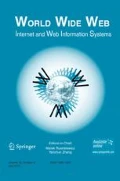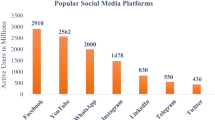Abstract
As a constructive mode of information sharing, collaboration and communication, social media platforms offer users with limitless opportunities. The same hypermedia can be transposed into a synthetic and toxic milieu that provides an anonymous, destructive pedestal for online bullying and harassment. Automatic cyberbullying detection on social media using synthetic or real-world datasets is one of a proverbial natural language processing problem. Analyzing a given text requires capturing the existent semantics, syntactic and spatial relationships. Learning representative features automatically using deep learning models efficiently captures the contextual semantics and word order arrangement to build robust and superlative predictive models. This work puts forward a hybrid model, Bi-GRU-Attention-CapsNet (Bi-GAC), that benefits by learning sequential semantic representations and spatial location information using a Bi-GRU with self-attention followed by CapsNet for cyberbullying detection in the textual content of social media. The proposed Bi-GAC model is evaluated for performance using F1-score and ROC-AUC curve as metrics. The results show a superior performance to the existing techniques on the benchmark Formspring.me and MySpace datasets. In comparison to the conventional models, an improvement of nearly 9% and 3% in F-score is observed for MySpace and Formspring.me dataset respectively.








Similar content being viewed by others
Data availability
Benchmark publicly available datasets have been used.
Code availability
Can be made available on request.
References
Agrawal, S., Awekar, A.: Deep learning for detecting cyberbullying across multiple social media platforms. In: European Conference on Information Retrieval, pp. 141–153. Springer, Cham (2018)
Ballal, N, Saritha, SK: A study of deep learning in text analytics. In: Shukla, R, Agrawal, J, Sharma, S, Chaudhari, N, Shukla, K (eds.) Social networking and computational intelligence. Lecture notes in networks and systems, vol. 100. Springer, Singapore (2020). https://doi.org/10.1007/978-981-15-2071-6_16
Bounegru, L, Gray, J, Venturini, T, Mauri, M: A field guide to 'fake news' and other information disorders. A field guide to" fake news" and other information disorders: a collection of recipes for those who love to cook with digital methods. Public Data Lab, Amsterdam (2018)
Campbell, MA: Cyber bullying: an old problem in a new guise? Aust. J. Guid. Couns. 15(1), 68–76 (2005)
Çiğdem, A.C.I., Çürük, E., Eşsiz, E.S.: Automatic detection of cyberbullying in FORMSPRING. Me, Myspace and Youtube Social Networks. Turk J Eng 3(4), 168–178 (2019)
Cho, K., Van Merriënboer, B., Gulcehre, C., Bahdanau, D., Bougares, F., Schwenk, H., Bengio, Y.: Learning phrase representations using RNN encoder-decoder for statistical machine translation. arXiv preprint arXiv:1406.1078 (2014)
Dadvar, M., Eckert, K.: Cyberbullying detection in social networks using deep learning based models; a reproducibility study. arXiv preprint arXiv:1812.08046 (2018)
Deng, J., Cheng, L., Wang, Z.: Self-attention-based BiGRU and capsule network for named entity recognition.arXiv preprint arXiv:2002.00735 (2020)
Gangwar, A. K., Ravi, V.: A novel BGCapsule network for text classification. arXiv preprint arXiv:2007.04302 (2020)
Hang, O.C., Dahlan, H.M.: Cyberbullying lexicon for social media. In: 2019 6th International Conference on Research and Innovation in Information Systems (ICRIIS), pp. 1–6. IEEE (2019)
Hochreiter, S: The vanishing gradient problem during learning recurrent neural nets and problem solutions. Internat. J. Uncertain. Fuzziness Knowledge-Based Systems 6(02), 107–116 (1998)
Jain, D, Kumar, A, Garg, G: Sarcasm detection in mash-up language using soft-attention based bi-directional LSTM and feature-rich CNN. Appl. Soft Comput. 91, 106198 (2020)
John, A., Glendenning, A. C., Marchant, A., Montgomery, P., Stewart, A., Wood, S., ... Hawton, K.: Self-harm, suicidal behaviours, and cyberbullying in children and young people: systematic review. J. Med. Internet Res. 20(4), e129 (2018)
Kowalski, RM, Limber, SP: Psychological, physical, and academic correlates of cyberbullying and traditional bullying. J. Adolesc. Heal. 53(1), S13–S20 (2013)
Kim, J, Jang, S, Park, E, Choi, S: Text classification using capsules. Neurocomputing 376, 214–221 (2019)
Kumar, A., Sachdeva, N.: Cyberbullying detection on social multimedia using soft computing techniques: a meta-analysis. Multimed Tools Appl 78(17), 23973–24010 (2019)
Kumar, A, Jaiswal, A: A deep swarm-optimized model for leveraging industrial data analytics in cognitive manufacturing. IEEE Trans. Industr. Inf. 17(4), 2938–2946 (2020)
Kumar, A., Sachdeva, N.: Cyberbullying checker: online bully content detection using Hybrid Supervised Learning. In: International Conference on Intelligent Computing and Smart Communication 2019, pp. 371–382. Springer, Singapore (2020)
Kumar, A., Sachdeva, N.: Multi-input integrative learning using deep neural networks and transfer learning for cyberbullying detection in real-time code-mix data. Multimedia Systems, 1–15 (2020)
Kumar, A., Sachdeva, N.: Multimodal cyberbullying detection using capsule network with dynamic routing and deep convolutional neural network. Multimedia Systems, 1–10 (2021)
Kumar, A., Sangwan, S.R., Arora, A., Nayyar, A., Abdel-Basset, M.: Sarcasm detection using soft attention-based bidirectional long short-term memory model with convolution network. IEEE Access 7, 23319–23328 (2019)
Kumar, A., Srinivasan, K., Cheng, W.H., Zomaya, A.Y.: Hybrid context enriched deep learning model for fine-grained sentiment analysis in textual and visual semiotic modality social data. Inf Process Manag 57(1), 102141 (2020)
Liu, W., Wen, B., Gao, S., Zheng, J., Zheng, Y.: A multi-label text classification model based on ELMo and attention. In: MATEC Web of Conferences, Vol. 309, pp. 03015. EDP Sciences (2020)
Maslej-Krešňáková, V, Sarnovský, M, Butka, P, Machová, K: Comparison of deep learning models and various text pre-processing techniques for the toxic comments classification. Appl. Sci. 10(23), 8631 (2020)
Meng, Z, Tian, S, Yu, L: Regional bullying text recognition based on two-branch parallel neural networks. Autom. Control. Comput. Sci. 54(4), 323–334 (2020)
Özel, SA, Sarac, E: Effects of feature extraction and classification methods on cyberbully detection. Süleyman Demirel Üniversitesi Fen Bilimleri Enstitüsü Dergisi 21(1), 190–200 (2016)
Paul, S., & Saha, S. (2020). CyberBERT: BERT for cyberbullying identification.Multimedia Systems, 1–8.
Peters, M. E., Neumann, M., Iyyer, M., Gardner, M., Clark, C., Lee, K., Zettlemoyer, L.: Deep contextualized word representations.arXiv preprint arXiv:1802.05365 (2018)
Rosa, H, Pereira, N, Ribeiro, R, Ferreira, PC, Carvalho, JP, Oliveira, S, Coheur, L, Paulino, P, Simão, AV, Trancoso, I: Automatic cyberbullying detection: a systematic review. Comput. Hum. Behav. 93, 333–345 (2019)
Sabour, S., Frosst, N., Hinton, G. E.: Dynamic routing between capsules. arXiv preprint arXiv:1710.09829 (2017)
Sangwan, S.R., Bhatia, M.P.S.: D-BullyRumbler: a safety rumble strip to resolve online denigration bullying using a hybrid filter-wrapper approach. Multimedia Systems, 1–17 (2020)
Shao, Y, Lin, JCW, Srivastava, G, Jolfaei, A, Guo, D, Hu, Y: Self-attention-based conditional random fields latent variables model for sequence labeling. Pattern Recogn. Lett. 145, 157–164 (2021)
Sherstinsky, A: Fundamentals of recurrent neural network (RNN) and long short-term memory (LSTM) network. Physica D 404, 132306 (2020)
Shrivastava, G., Kumar, P., Ojha, R.P., Srivastava, P.K., Mohan, S., Srivastava, G.: Defensive modeling of fake news through online social networks. IEEE Trans Comput Soc Syst 7(5), 1159–1167 (2020)
Smith, PK, Mahdavi, J, Carvalho, M, Fisher, S, Russell, S, Tippett, N: Cyberbullying: Its nature and impact in secondary school pupils. J. Child Psychol. Psychiatry 49(4), 376–385 (2008)
Van Hee, C, Jacobs, G, Emmery, C, Desmet, B, Lefever, E, Verhoeven, B, Hoste, V: Automatic detection of cyberbullying in social media text. PLoS ONE 13(10), e0203794 (2018)
Young, T, Hazarika, D, Poria, S, Cambria, E: Recent trends in deep learning based natural language processing. IEEE Comput. Intell. Mag. 13(3), 55–75 (2018)
Zhang, A., Li, B., Wan, S., Wang, K.: Cyberbullying detection with birnn and attention mechanism. In: International Conference on Machine Learning and Intelligent Communications, pp. 623–635. Springer, Cham (2019)
Zhao, R., Zhou, A., Mao, K.: Automatic detection of cyberbullying on social networks based on bullying features. In: Proceedings of the 17th international conference on distributed computing and networking, pp. 1–6 (2016)
Zhao, W., Ye, J., Yang, M., Lei, Z., Zhang, S., Zhao, Z.: Investigating capsule networks with dynamic routing for text classification. arXiv preprint arXiv:1804.00538 (2018)
Author information
Authors and Affiliations
Contributions
All the authors have contributed equally in the research and manuscript preparation.
Corresponding author
Ethics declarations
Ethics approval
The work conducted is not plagiarized. No one has been harmed in this work.
Consent to participate
All the authors have given consent to submit the manuscript.
Consent for publication
Authors provide their consent for the publication.
Conflict of interest
The authors certify that there is no conflict of interest in the subject matter discussed in the manuscript.
Additional information
Publisher’s note
Springer Nature remains neutral with regard to jurisdictional claims in published maps and institutional affiliations.
This article belongs to the Topical Collection: Special Issue on Synthetic Media on the Web
Guest Editors: Huimin Lu, Xing Xu, Jože Guna, and Gautam Srivastava
Rights and permissions
About this article
Cite this article
Kumar, A., Sachdeva, N. A Bi-GRU with attention and CapsNet hybrid model for cyberbullying detection on social media. World Wide Web 25, 1537–1550 (2022). https://doi.org/10.1007/s11280-021-00920-4
Received:
Revised:
Accepted:
Published:
Issue Date:
DOI: https://doi.org/10.1007/s11280-021-00920-4




